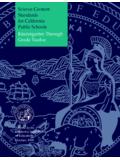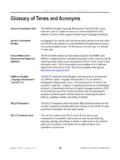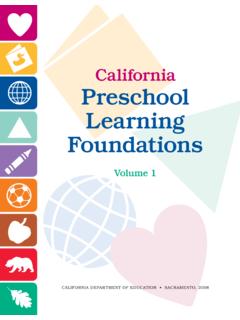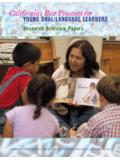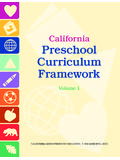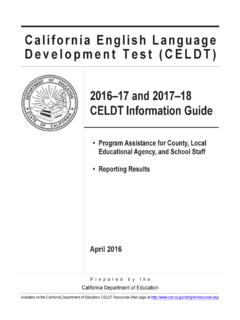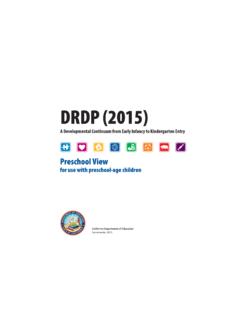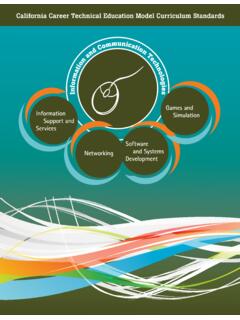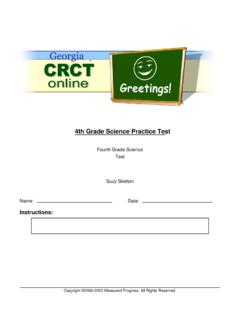Transcription of Science Content Standards - Curriculum Frameworks (CA …
1 STATATIONEBOAR D O F EDUC Adopted by the california State Board of Education October, 1998 Science Content Standards for california Public Schools Kindergarten Through grade Twelve california Department of EducationReposted June 11, 2009 Science Content Standards for california Public Schools Kindergarten Through grade Twelve (Reprinted, 2003) california Department of EducationReposted June 11, 2009 STATE OF california DEPARTMENT O F EDUCATION Publishing Information When the Science Content Standards for california Public Schools, Kindergarten Through grade Twelve was adopted by the california State Board of Education on October 9, 1998, the members of the State Board were the following: Yvonne W. Larsen, President; Robert L. Trigg, Vice-President; Marian Bergeson; Timothy C. Draper; Kathryn Dronenburg; Marion Joseph; Marion McDowell; Janet G. Nicholas; Gerti B. Thomas; Marina Tse; and Richard Weston.
2 This publication was edited by Sheila Bruton and Faye Ong, working in cooperation with Greg Geeting, Executive Director, State Board of Education. It was designed and prepared for printing by the staff of CDE Press, with the cover and interior design created and prepared by Cheryl McDonald. Typesetting was done by Jamie Contreras and Carey Johnson. It was published by the california Department of Education, 1430 N Street, Sacramento, california (mailing address: Box 944272, Sacramento, CA 94244-2720). It was distributed under the provisions of the Library Distribution Act and Government Code Section 11096. 2000 by the california Department of Education All rights reserved Reprinted with revised introductory material in June 2003. ISBN 0-8011-1496-9 Special Acknowledgment The State Board of Education extends its appreciation to Stan Metzenberg, Science Standards Consult ant, california State University, Northridge; Bonnie Brunkhorst, Science Standards Consultant, california State University, San Bernardino; and the members and executive staff of the Commission for the Establishment of Academic Content and Performance Standards (Academic Standards Commission) for their outstanding work in developing and recommending the Science Content Standards to the State Board of Education under the provisions of Education Code Section 60605.
3 The members and executive staff of the Academic Standards Commission at the time of the approval of the draft Science Content Standards were the following: Ellen Wright, Chair*; Robert Calfee, Vice Chair; Mike Aiello*; Joseph Carrabino*; Judy Codding; Daniel Condron*; Linda Davis*; Bill Evers*; Tony Fisher*; Jerilyn Harris*; Dorothy Jue Lee*; Mark Ortiz*; Judith Panton; Raymund Paredes; Alice Petrossian; Glenn T. Seaborg*; Kate Simpson; Lawrence Siskind; Jerry Treadway; LaTanya Wright; Delaine Eastin, State Superintendent of Public Instruction; Sonia Hernandez*, the Superintendent s Designee; Scott Hill, Executive Director; Sheila Byrd, Deputy Executive Director; and Paul Thallner, Senior Consultant. Note: The asterisk (*) identifies those members who served on the Academic Standards Commission s Science Committee. Special commendation is extended to the outstanding leadership of the late Glenn T. Seaborg, Chair of the Academic Standards Commission s Science Committee, to whom this document is dedicated; Janet G.
4 Nicholas, State Board of Education member; and Rollie Otto, Head of the Center for Science and Engineering Education, E. O. Lawrence Berkeley National Laboratory, and Consultant to the Academic Standards Commission s Science Committee. Their service and contributions to this document deserve special recognition. Ordering Information Copies of this publication are available for $9 each, plus shipping and handling charges. california residents are charged sales tax. Orders may be sent to the california Department of Education, CDE Press, Sales Office, Box 271, Sacramento, CA 95812-0271; FAX (916) 323-0823. See page 53 for complete information on payment, including credit card purchases, and an order blank. Prices on all publications are subject to change. In addition, an illustrated Educational Resources Catalog describing publications, videos, and other instructional media available from the Department can be obtained without charge by writing to the address given above or by calling the Sales Office at (916) 445-1260.
5 Notice The guidance in Science Content Standards for california Public Schools, Kindergarten Through grade Twelve is not binding on local educational agencies or other entities. Except for the statutes, regulations, and court decisions that are referenced herein, the document is exemplary, and compliance with it is not mandatory. (See Education Code Section ) california Department of EducationReposted June 11, 2009 There can be no doubt that scientific literacy .. is now more important than ever before. A Nation at Risk Revisited To Glenn Theodore Seaborg Born: April 19, 1912, Ishpeming, Michigan Died: February 25, 1999, Lafayette, california Glenn Theodore Seaborg was instrumental in the design and development of the Science Content Standards . Dr. Seaborg was one of the foremost scien tific minds of the twentieth century, and his legacy is without parallel: Research scientist, discoverer of countless atomic isotopes and ten elements, including plutonium and the element that bears his name, seaborgium, and formulator of the actinide concept of heavy element electronic structure, one of the most sig nificant changes in the periodic table of elements since Mendeleev s nineteenth-century design Chairman of the Atomic Energy Commission under presidents Kennedy, Johnson, and Nixon Cofounder of the Lawrence Hall of Science , Berkeley Recipient of the Nobel Prize in chemistry Member of President Reagan s National Commis sion on Excellence in Education Recipient of the National Medal of Science Chairman, Science Committee, california Commis sion for the Establishment of Academic Content and Performance Standards The vitality of a democracy assumes a certain core of knowledge shared by everyone which serves as a unifying force.
6 It is fundamental to the effectiveness of our democratic system that our citizens be able to make informed judgments on the more and more complex issues of scientific and technological public policy. A Nation at Risk Revisited iii california Department of EducationReposted June 11, 2009 Contents A Message from the State Board of Education and the State Superintendent of Public Instruction .. vi Introduction .. vii Kindergarten .. 1 grade One .. 3 grade Two .. 5 grade Three .. 8 grade Four .. 11 grade Five .. 14 grade Six .. 18 grade Seven .. 22 grade Eight .. 26 Grades Nine Through Twelve .. 31 v california Department of EducationReposted June 11, 2009A Message from the State Board of Education and the State Superintendent of Public Instruction In 1998 california adopted academically rigorous Content Standards in Science . The adoption of stan dards in each core subject area marked a turning point in the education reform movement that began in 1983 with the report A Nation at Risk: The Imperative for Educational Reform, by the National Commission on Excellence in Education.
7 Until then, the reform movement had focused on important but largely structural improvements, such as more instructional time, minimum course requirements for high school diplomas, and an emphasis on local planning efforts to promote efficiency and effectiveness. The desire to improve student achievement was there, but the focus on Content that is, a comprehensive, specific vision of what students actually needed to know and be able to do was lacking. Standards are a bold initiative. Through Content Standards in the core subjects, california began to redefine the state s role in public education. For the first time, the knowledge and skills that students needed to acquire were explicitly stated for the most part by grade level, although Science Standards at the high school level were organized by discipline. The Standards are rigorous. Students who master this Content are on a par with those in the best educational systems in other states and nations.
8 The Content is attainable by all students, given sufficient time, except for those few who have severe disabilities. We continue to regard the Standards as firm but not unyielding; they will be modified in future years to reflect new research and scholarship. Standards describe what to teach, not how to teach it. Standards -based education maintains california s tradition of respect for local control of schools. To help students achieve at high levels, local educators with the full support and cooperation of families, busi nesses, and community partners have taken these Standards and designed the specific curricular and instructional strategies that best deliver the Content to their students. Their efforts have been admirable. Standards are here to stay. Since the Science Content Standards were adopted, much has been done to align all of the state s efforts in Curriculum , instruction, assessment, teacher preparation, and professional development to the Standards .
9 Educators now see these Science Content Standards as the foundation for their work, not as an additional layer. Standards are a continuing commitment to excellence. The adoption of Science Content Standards and the work to align the whole of the educational system to them have placed our state on the path to success in Science education. The Standards have brought certainty of knowledge and purpose to all. They are comprehensive and specific. They reflect our continu ing commitment to excellence. REED HASTINGS President, State Board of Education JACK O CONNELL State Superintendent of Public Instruction JUNE 2003 vi california Department of EducationReposted June 11, 2009 Introduction The Science Content Standards for california Public Schools, Kindergarten Through grade Twelve represents the Content of Science education and includes the essential skills and knowledge students will need to be scientifically literate citizens in the twenty-first century.
10 By adopting these Standards , the State Board of Education affirms its commitment to provide a world-class Science education for all california students. These Standards reflect the diligent work and commitment of the Commission for the Establishment of Academic Content and Performance Standards (Academic Standards Commission) and the commission s Science Committee to define the common academic Content of Science education at every grade level. Glenn T. Seaborg, one of the great scien tific minds of this time and of all times, chaired the Academic Standards Commis sion s Science Committee. In A Letter to a Young Scientist, Dr. Seaborg said, Science is an organized body of knowledge and a method of proceeding to an extension of this knowledge by hypothesis and experiment. 1 The National Science Education Standards reflects this view of Science and the balance between the body of knowledge and the method of scientific The stan 1 Gifted Young in Science : Potential Through Performance.
